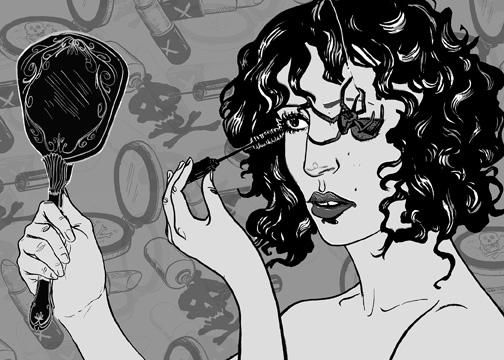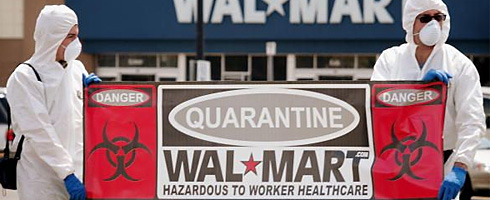U.S. scientists say they have developed a method of "fooling" a bacterium's evolutionary machinery into programming its own death.
Researchers at the University of Illinois and the University of Massachusetts at Amherst said their achievement shows a synthetic "hole punching" anti-microbial depends upon the presence of phosphoethanolamine -- a cone-shaped lipid found within Gram-negative bacterial membranes.
"The basic idea is for an antimicrobial to target something in a bacteria that, in order to gain immunity, would require the bacteria to kill itself through a suicide mutation," said UI Professor Gerard Wong, corresponding author of the study.
Chinese authorities have begun destroying and vaccinating poultry after an outbreak of bird flu was discovered in the east of the country, the agriculture ministry said Tuesday.
The deadly H5N1 strain of the virus was discovered on a chicken farm in Dongtai city and in another farm in Haian county both in eastern Jiangsu province, the ministry said in a statement posted on its website.
The discovery had prompted local agricultural authorities to step up vaccinations, while culling 377,000 chickens in the area around the farms.
The spread of the virus had not been detected in any other areas around the two farms, it added.
"Preliminary expert analysis from tests have found... The farm poultry could have been infected by migratory birds," it said.
Sinks installed in hospital rooms to prevent infections actually turned out to be the source of a superbug infection in a Toronto hospital that killed 12 people, a journal article says.
The deaths occurred in the surgical intensive care unit of Toronto General Hospital between December 2004 and March 2006. A total of 36 patients either became sick or carried the bacteria without illness.
The ICU had recently been renovated when patients started getting sick with a multi-drug-resistant strain of Pseudomonas aeruginosa, but doctors couldn't figure out how it was being spread. The bacteria thrive in drains, where they form sludges called biofilms.
Australians traveling to Bali are being warned about an outbreak of rabies.
The Indonesian island was considered to be rabies free until the disease was diagnosed last week in two dogs in Kuta, a beach frequented by Australians. Rabies affects the brain and is almost always fatal without treatment. The usual incubation period for the disease is three to eight weeks.
The NT Department of Health and Families has issued a statement warning people visiting the island to avoid dogs, cats and monkeys.
When it comes to ordinary maladies, if you name it they will come
New terms for familiar ailments can result in more people seeking medication, says a study released Monday by researchers at McMaster University in Hamilton, Ontario.
The study looked at the effect of using impressive-sounding medical terms for common conditions.
Someone who is told she has hyperhidrosis, for instance, may be more concerned than if her doctor calls it excessive perspiration. Similarly, pityriasis capitis sounds a lot scarier than dandruff.
Co-author Meredith Young says that conditions previously considered to be on the fringes of normal health, or associated with the normal aging process, are becoming seen as diseases that need to be treated.
Young, a graduate student, says this may be a direct result of what some medical professionals refer to as "disease-mongering," accusing pharmaceutical companies of creating new diseases in order to sell drugs. For example, if someone who may be going bald is convinced that he has a disease called androgenic alopecia, he may be more likely to seek a drug to treat it.

© Taryn Egan
From the pages of every mainstream women's magazine - between the list of 43 things every confident woman knows and the six-week ab-blasting plan - the ads beckon. Conditioners enriched with vitamins vow to make each strand 10 times stronger. Undereye concealers containing white-tea antioxidants claim to combat the cellular damage that deepens those oh-so-unsightly dark circles. Pricey foundations promise to rejuvenate the face at the molecular level with the new Pro-Xylane compound, carefully extracted from Eastern European beech trees. These days, more and more personal care products are promising to harness the power of nature to beautify us from the inside out. Makeup doesn't merely make us look good, we're told - now it's good for us, too.
Jeremy Brecher, Tim Costello and Brendan Smith
TruthoutMon, 15 Dec 2008 22:47 UTC

© Scott Olson / Getty ImagesActivists protest Wal-Mart's health care coverage. More and more workers are struggling with inadequate employer-based coverage.
As Americans respond to President-elect Obama's call for town hall meetings on reform of the American health care system, an understanding of how that system came to be the way it is can be crucial for figuring out how to fix it. The American health care system is unique because, for most of us, it is tied to our jobs rather than to our government. For many Americans, the system seems natural, but few know that it originated not as a well-thought-out plan to provide for Americans' health, but as a way to circumvent a quirk in wartime wage regulations that had nothing to do with health.
Maryn McKenna
SelfThu, 16 Oct 2008 20:19 UTC
For Emily White, it felt like the worst flu ever. It was in the spring of 2006, and White was pushing through her final term at college. Sure, she was stressed and run-down. But she just didn't understand how her symptoms could be so intense.
White, then 22, was headed to law school, and would lie awake at night, her mind running nonstop over paying for school, keeping her friendships going, maintaining her 3.8 grade point average and living up to the law-firm job she'd snagged for the summer. She was exhausted, yet sleep was impossible. This didn't feel like run-of-the-mill anxiety, though. It was something physical. All over her body - throat, armpits, groin - her lymph nodes swelled up, and she ran a fever. Her face grew lumps, painful and hot, like cystic acne that refused to get better. She dragged herself to class but had trouble putting words together.
And then, within a couple of weeks, the lumps on her face sprouted...something. At first, she thought they were hairs and tried to yank them with tweezers, but they felt "rooted in cement," she says. Her skin had always been good; but for the first time in her life, she spackled on concealer to try to hide the bristly rash.
Ran Reznick
HaaretzTue, 16 Dec 2008 18:49 UTC
The Health Ministry has launched an investigation into the sudden deaths in the past month of four babies and the severe illness of two others.
The cases, some of which were reported to the ministry in recent weeks by hospitals, including Schneider Children's Medical Center and the Sourasky Medical Center in Tel Aviv, involved serious neurological and cardiac damage to the babies, but in most of the cases, no reason has been determined as yet for the illnesses or the deaths. The initial ministry probe has turned up no connection among all six cases, although the ministry is still seeking one.
Hattie Kauffman
CBS NewsFri, 04 Mar 2005 16:55 UTC
Could mold inside your home or apartment be deadly?
One California woman believes toxic mold killed her 2-year-old daughter. She's joined dozens of other tenants in a lawsuit. The Early Show National Correspondent Hattie Kauffman reports.
As Jennifer Lair walks her daughter, Skyla, and a friend, to school, she fears Skyla will once again expect her little sister, Neveah, to be home at the end of the day.
Lair says, "Skyla, she, at first, she was angry. Now she just questions: When is she coming home? Or is she coming home?"
Two-year-old Neveah Lair died suddenly last year.